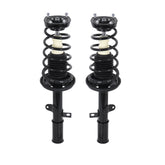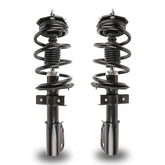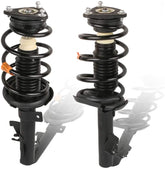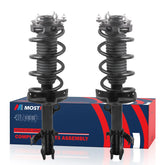What is a strut?
What is a strut?
The strut is one of several types of shock absorbers used on all front-wheel drive vehicles today. The strut is attached to the steering knuckle, which is connected to the lower control arm by a joint.
This part is part of the suspension structure itself; it may be replaced by an upper control arm and ball joint on certain suspensions. However, the strut is lighter and takes up less space than other types of suspension. For these two reasons, they are more commonly used.
Generally speaking, the strut is made up of a spring that supports the weight of the car, and a strut housing and shock absorber cups with a damper whose role is to control the movement of the spring and suspension.

The strut is used for the following two functions:
- Damping: it works in conjunction with the shock absorbers;
- Tire alignment: by supporting the lateral weight of the vehicle, it helps maintain tire alignment and ensure ride comfort.
- The strut is an integral part of the vehicle's handling, control, braking, and wheel geometry.
As such, the strut is a critical component to the safety and reliability of your vehicle while you're on the road.
How does the strut work?
The strut is similar to a conventional shock absorber. There are two types of shocks:
- The Sealed Strut: The top of the strut is in a permanently closed position, preventing access to the shock absorber cartridge inside the strut. If there is a problem with the shock absorber, the strut must be replaced.
- Replaceable Strut or Replaceable Cartridge: The top of the strut tube is protected by a rod and threaded sleeve. This allows the shock cartridge to be replaced. The shock absorber is submerged in oil to lubricate the inner wall and is sealed by an O-ring.
The piston at the end of the rod pushes the hydraulic fluid to move the spring and thus the suspension. The strut is equipped with a valve system to accommodate increases and decreases in suspension travel speed.
This system applies varying degrees of pressure to slow the vehicle and maintain driver control.

When should a strut be replaced?
There are a number of signs that can alert you to the need to replace your vehicle's strut. Generally speaking, wear and tear on this part of the suspension system can be seen as follows:
- Difficulty controlling the vehicle: when driving, you lose fluidity and road holding;
- Shocks are felt: there is a significant loss of comfort for the vehicle's occupants;
- Tires wear out quickly: the wear indicator on your tires becomes increasingly visible;
- Braking is dangerous: when braking, you feel the vehicle bounce or lose its grip on the ground;
- High risk of aquaplaning: in the rain, even if you are driving slowly, you may find yourself in an aquaplaning situation.
- Instability at highway speeds: when driving on highways or at high speeds, your car never seems completely stable, constantly rising and falling.
- Rear squat under acceleration: When you accelerate your car, you may notice that the front of your vehicle lifts while the rear squats.
A car's suspension will wear out over time. However, this wear depends on a number of factors:
- The condition of the roads you drive on every day;
- The type of driving you do;
- Climatic conditions.
- Rain, snow, sand, salt, and mud can accelerate the formation of corrosion on the strut, resulting in premature wear. Sporty or hard driving will also accelerate wear on the vehicle's suspension.
Finally, certain driving conditions, such as mainly urban driving, but also deteriorated roads (potholes, holes, etc.), contribute to accelerated strut wear.
On average, the suspension should be checked after 60,000 kilometers. The life of a strut is generally between 80 and 100,000 kilometers, but can sometimes reach 120 or even 150,000 kilometers.
Featured Products
- $125.99
- $125.99
- Unit price
- / per
- $172.98
- $172.98
- Unit price
- / per
- $142.99
- $142.99
- Unit price
- / per
- $169.99
- $169.99
- Unit price
- / per
















